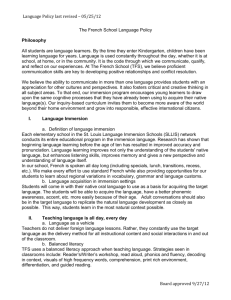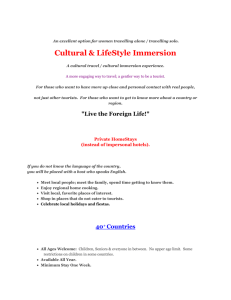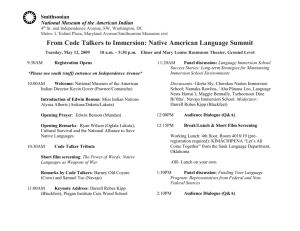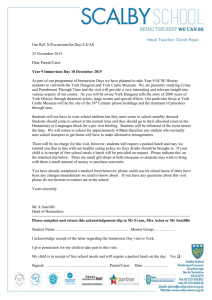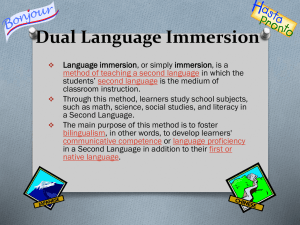immersion, presence, and flow in robot-aided isr simulation
advertisement
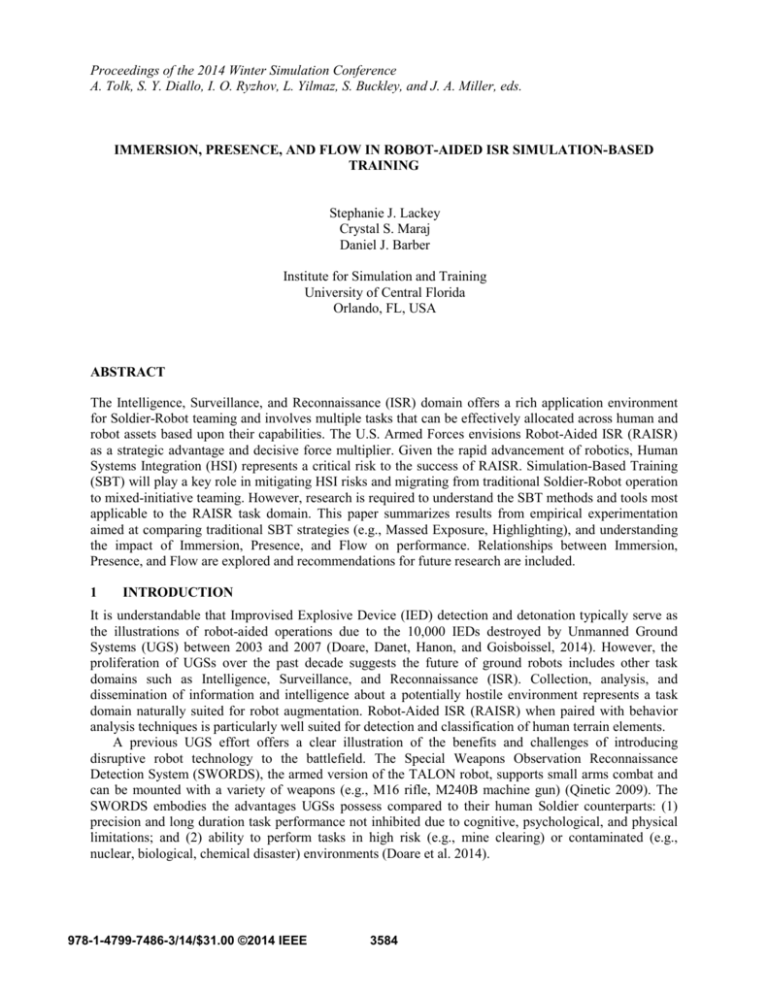
Proceedings of the 2014 Winter Simulation Conference A. Tolk, S. Y. Diallo, I. O. Ryzhov, L. Yilmaz, S. Buckley, and J. A. Miller, eds. IMMERSION, PRESENCE, AND FLOW IN ROBOT-AIDED ISR SIMULATION-BASED TRAINING Stephanie J. Lackey Crystal S. Maraj Daniel J. Barber Institute for Simulation and Training University of Central Florida Orlando, FL, USA ABSTRACT The Intelligence, Surveillance, and Reconnaissance (ISR) domain offers a rich application environment for Soldier-Robot teaming and involves multiple tasks that can be effectively allocated across human and robot assets based upon their capabilities. The U.S. Armed Forces envisions Robot-Aided ISR (RAISR) as a strategic advantage and decisive force multiplier. Given the rapid advancement of robotics, Human Systems Integration (HSI) represents a critical risk to the success of RAISR. Simulation-Based Training (SBT) will play a key role in mitigating HSI risks and migrating from traditional Soldier-Robot operation to mixed-initiative teaming. However, research is required to understand the SBT methods and tools most applicable to the RAISR task domain. This paper summarizes results from empirical experimentation aimed at comparing traditional SBT strategies (e.g., Massed Exposure, Highlighting), and understanding the impact of Immersion, Presence, and Flow on performance. Relationships between Immersion, Presence, and Flow are explored and recommendations for future research are included. 1 INTRODUCTION It is understandable that Improvised Explosive Device (IED) detection and detonation typically serve as the illustrations of robot-aided operations due to the 10,000 IEDs destroyed by Unmanned Ground Systems (UGS) between 2003 and 2007 (Doare, Danet, Hanon, and Goisboissel, 2014). However, the proliferation of UGSs over the past decade suggests the future of ground robots includes other task domains such as Intelligence, Surveillance, and Reconnaissance (ISR). Collection, analysis, and dissemination of information and intelligence about a potentially hostile environment represents a task domain naturally suited for robot augmentation. Robot-Aided ISR (RAISR) when paired with behavior analysis techniques is particularly well suited for detection and classification of human terrain elements. A previous UGS effort offers a clear illustration of the benefits and challenges of introducing disruptive robot technology to the battlefield. The Special Weapons Observation Reconnaissance Detection System (SWORDS), the armed version of the TALON robot, supports small arms combat and can be mounted with a variety of weapons (e.g., M16 rifle, M240B machine gun) (Qinetic 2009). The SWORDS embodies the advantages UGSs possess compared to their human Soldier counterparts: (1) precision and long duration task performance not inhibited due to cognitive, psychological, and physical limitations; and (2) ability to perform tasks in high risk (e.g., mine clearing) or contaminated (e.g., nuclear, biological, chemical disaster) environments (Doare et al. 2014). 978-1-4799-7486-3/14/$31.00 ©2014 IEEE 3584 Lackey, Maraj, and Barber However, in 2007 the initial introduction of three SWORDS units to Soldiers in Iraq encountered trust issues. Loose wiring, a flawed soldering connection, and a burned out motor resulted in unanticipated movements of the device (Sofge 2008). These incidents occurred prior to final safety certification (Weinberger, 2008), but never the less hindered acceptance of the device despite its advanced capabilities (Sofge 2008). Typical remedies to Human Systems Integration (HSI) challenges include familiarization training. Simulation-Based Training (SBT) often bridges the gap between classroom-based and field training. Additionally, SBT research offers an opportunity to proactively seek science-driven recommendations for acquisition, design, and development decision-makers. SBT is primed to mitigate HSI risks and issues facing RAISR. This research thrust focuses on discerning what SBT methods and tools, previously proven effective in other domains, fit RAISR training needs. 1.1 Objective The objective for the research presented was to investigate the effects of Immersion, Presence, and Flow on RAISR performance between Highlighting and Massed Exposure instructional strategies. Additionally, this experiment assessed Immersion, Presence, and Flow as predictors of performance and the relationship between Immersion and each measure. This paper reports the results from an empirical assessment of these three constructs within a simulated RAISR environment and drives recommendations for future SBT systems. 1.2 Measures The lack of a standard definition for the term Immersion necessitates addressing the prevailing characterizations. Witmer and Singer (1998) describe Immersion as the state of interaction with an environment providing a continuous stream of stimuli and experiences; while others view Immersion as an objective evaluation of the technology within a Virtual Environment (VE) (Slater and Usoh 1993). In an attempt to disambiguate the term, Sherman and Craig (2003) specify mental Immersion as the emotional or mental state of being involved in an environment, and physical Immersion referring to the body entering the medium. Frequently, Immersion has been related to video game research. Jennett, Cox, Cairns, Dhoparee, Epps, Tijs, et al. (2008) as well as Charlton and Danforth (2007) conducted research on computer-related video game behavior revealing that immersive tendencies are linked to how engaged the individual finds the task creating deeper feelings of Immersion. These experimental results imply that Immersion is a predictor of immersive experiences. Immersion has been correlated with other immersive measures (e.g., Presence) to assess task performance (Slater, Linakis, Usoh and Kooper 1996; Witmer and Singer 1998; Slater and Usoh 1993). However, a more exhaustive review of the literature revealed deficiencies in assessing Immersion as a single predictor of performance. The concept of Presence describes the feeling of “being there” in the VE rather than experiencing stimuli from the physical world (IJsselsteijn, de Ridder, Freeman and Avons 2000; Witmer and Singer, 1998). Presence has been studied because of its significant relationships to performance (Barfield, Sheridan, Zeltzer, and Slater 1995). Past research has shown a positive correlation between Presence and task performance within a VE (Stanney and Salvendy 1998; Schumie, van der Straaten, Krijin and van der Mast, 2001). When using VEs for training, the methodology distinguishes Presence from Immersion by definition and application (Slater and Usoh 1993; Witmer and Singer 1998). Both concepts have been used to evaluate performance; however, there is little or no research available correlating Immersion with Presence within RAISR tasks. Like Immersion and Presence, the concept of Flow has varying definitions across the spectrum of research. However, Flow is distinct from Immersion and Presence in that Flow refers to a state whereby an individual is engaged in an activity that is challenging but not beyond their skill level (Douglas and Hargadon 2000; Csikszentmihalyi 1975). Flow as a measure has rarely been directly correlated with task performance in the literature (Engeser and Rheinberg 2008). However, assumptions exist suggesting Flow influences performance. According to Csikszentmihalyi (1992), Flow is experienced when there is a 3585 Lackey, Maraj, and Barber balance between changes in the task activities and the required skills. Flow becomes attainable if the balance is achieved at a high performance level. Therefore, Flow should lead to higher performance. This theory has found support in an e-learning environment where students who scored higher on Flow performed better in the subsequent test (Weibel, Stricker and Wissmath, 2011). Research into the concept of Flow as it relates to Immersion is marginal. Weibel and Wissmath (2011) found Flow to be related to one or more of spatial Immersion, Presence and immersive tendencies constructs. The relationships of these constructs have found some merit in computer gaming where Flow accounts for more variance than Presence in computer role-playing games as well as immersive tendencies (Egenfeldt-Nielson, Smith and Tosca 2013). 2 2.1 METHOD Participants Ninety participants from the University of Central Florida and its affiliated organizations were recruited to participate in this research experiment. Participants were asked to participate using the Institute for Simulation and Training (IST)-SONA sign-up system. Criteria for participation included: U.S. citizenship, age ranges between 18-40, and normal or corrected to normal vision. The biographical data revealed that the sample was comprised of 44 males and 46 females, ages ranged from 18 to 38 (M = 21.57, SD = 3.25). Participants were compensated $10 per hour for up to 2 hours of participation. 2.2 Experimental Conditions A between-group design was implemented to assess the impact of different training strategies with identical pre-and post-conditions. The pre- and post-conditions were scenarios with identical test criteria that did not apply any instructional strategies. Training scenarios included Control, Massed Exposure, and Highlighting conditions. Highlighting uses visual features to orient an individual’s attention on elements that are critical to a task (Carroll, Milham, and Champney 2009). Specifically, the Highlighting condition focused the trainee’s attention to critical cues in the virtual environment where target cues were highlighted using a translucent blue box. The Massed Exposure strategy advocates a large number of training events to enhance an individual’s awareness to a task (Hirumi and Stapleton 2009). Within the experiment presented, the Massed Exposure condition contained twice as many target cues as the Highlighting and Control conditions (Moog and Bradley 2002). In order to elicit a moderate level of workload, a target detection rate of 30 events per minute was selected based on findings from Abich, Taylor, and Reinerman-Jones (2013). The signal (target) probability for pre-and post-conditions as well as the Highlighting and Control conditions was (1:3) whereas for the Massed Exposure condition the signal was doubled to (2:3). Figure 1 illustrates the training scenario viewed within the VE for each condition type. In the figure below, the Control and Massed Exposure visual representations do not look noticeably different, however, it is important to remember that the Massed Exposure condition has twice as many target cues. 3586 Lackey, Maraj, and Barber Figure 1: Examples of the Training Scenarios within the VE. 2.3 Experimental Testbed The experimental testbed was comprised of scenarios developed using Virtual Battlespace 2 (VBS2) software version 2.0. The U.S. Army uses VBS2 for SBT. For this research initiative, four training scenarios involving RAISR reconnaissance tasks were generated, each with a different terrain: Middle Eastern Marketplace, Middle Eastern Urban, Culturally Agnostic Urban, and Culturally Agnostic Suburban. These terrains were selected for generalizability across different cultures. The Culturally Agnostic was specifically chosen because the scenario elements were not localized to any cultural group. Further, the pre-and post-test scenarios used the Culturally Agnostic combining both Urban and Suburban terrains. The scenario environments consisted of 16 virtual characters that were either male or female with an array of skins tones that varied from light to dark. Target characters portrayed kinesic cues representing Aggressiveness or Nervousness (Salcedo, Lackey and Reinerman-Jones 2014). Non-target characters were selected from the library catalog within VBS2. The training scenarios were presented on a 22-inch widescreen computer monitor at 1680 x 1050 resolution. Each participant was required to detect and classify kinesic cues exhibited by virtual characters which appeared 3 meters apart on the screen. Finally, the same environments were used for all experimental groups, with only modification being the instructional strategy employed. 2.4 Metrics The survey data collected utilized a demographic questionnaire to gather biographical information about the participants’ sex, age, education level, military experience, and computer proficiency. The Immersion Survey was used to assess how involved the participant becomes while completing the experimental tasks using a 1-5 rating scale (Charlton and Danforth 2007; Jennett et al., 2008). The Presence Questionnaire comprised of a 1-7 rating scale to determine the level of Presence experienced during the task (Witmer and Singer 1998). The Flow State Short Scale (FSS) was made up of a 1-5 rating scale used to assess how much Flow was experienced during the task (Jackson, Martin, and Ekland 2008). The Simulator Sickness Questionnaire (SSQ) was designed to monitor an individual’s health status when exposed to the simulator. Symptoms include disorientation, nausea, and occulomotor disruption and was evaluated using a four point scale labeled with None, Slight, Moderate or Severe levels (Kennedy, Lane, Berbaum, and Lilienthal 1993). Performance data was collected during the pre- and post-test as well as each training scenario. The pre-and post-test were used to assess performance outcomes. The performance data collected during the experiment logged detection accuracy, classification accuracy, adjusted classification accuracy, median response time and average distance to target. Specifically, detection accuracy was calculated by the number of targets correctly identified divided by the total number of target stimuli presented and reported 3587 Lackey, Maraj, and Barber as a percentage. Classification accuracy was calculated by the number of targets correctly classified divided by the total number of target stimuli presented and reported as a percentage. Adjusted classification accuracy was calculated by the number of correctly classified targets divided by the number of correctly detected targets and reported as a percentage. The median response time indicated the median difference between the appearance of a target cue and the moment the target was selected in milliseconds. The average distance to target indicates the average distance between targets and the virtual UGS camera upon detection. Average distance to target was reported in meters 2.5 Procedure Upon arrival, the participant was escorted to the experimental laboratory room where the individual sat at a participant station. The participant read the informed consent before proceeding to answer a series of pre-experimental questions asked by the experimenter to assess use of alcohol, sedatives, anti-psychotics, or anti-depressants within a 24 hour time period or caffeine intake within the past 2 hours. Responses were noted by the experimenter and the answers were used to compare individual differences during performance data analysis. Next, the Ishihara Test for Color Blindness was administered (Ishihara 2013). Any participant unable to pass the color blindness test was dismissed. After completion of the initial questionnaires, the participant completed an interface training scenario to become familiar with the classification procedure. The task required the participant to detect, select, and classify colored barrels. Once the participant passed the detection and classification task, the participant completed the pre-test scenario. After completing the pre-test scenario, the participant completed the SSQ. Next the participant proceeded to the training phase. A PowerPoint presentation was narrated describing kinesic cues and a brief explanation of how to identify and classify each cue of interest. Participants in the Highlighting and Massed Exposure conditions received additional instructions explaining the associated instructional strategy. The participant then completed four training scenarios, one of each terrain type, presented in a randomized order. Each scenario lasted approximately 2-3 minutes. After completing all scenarios, the participant completed the SSQ followed by the FSS and Immersion Survey. Following the training scenarios, the participant completed the post-test scenario which was the reversed route of the pre-test. The duration of the test lasted less than 10 minutes which was followed by the SSQ. The participant then completed the last Presence Questionnaire. Finally, the participant was debriefed and dismissed. Compensation was given at a designated later date. Table 1 summarizes the experimental procedure. Table 1: Summary of Experimental Procedure Informed Consent Initial Questionnaire: Pre-experimental Questions Color Blindness Assessment PowerPoint Interface Training Pre-Test Training 1 Training 2 Training 3 Training 4 Complete Questionnaires: SSQ,FSS, and Immersion Survey Post-test Final Questionnaires: SSQ and Presence Questionnaire Debrief and Dismiss 3588 Lackey, Maraj, and Barber 3 RESULTS Preliminary analyses confirmed that no violation of assumptions of normality, linearity, and homoscedasticity occurred. A series of multiple linear regressions were conducted to assess overall Presence as a predictor of performance for all conditions. The results found overall Presence accounted for 15.1% of the variance for post-test detection accuracy (β = .40, F(1, 88) = 16.89, p < .01, R2 = .16). Additionally, overall Presence explained 3.8% of the variance for post-test median response time (β = .22, F(1, 88) = 4.52, p < .05, R2 = .05). Overall Presence also explained 5.2% of the variance for post-test average distance to target (β = .25, F(1, 88) = 5.90, p < .05, R2 = .06). Next, to assess the impact of the Presence subscales as a predictor of performance for all conditions, multiple linear regressions were conducted and the results suggested that the Presence subscales explained 17% of the variance for post-test detection accuracy (R2 = .21, F(4, 85) = 5.53, p < .01). Specifically, the Interface Quality subscale significantly predicted post-test detection accuracy (β = .27, p < .01). The results also indicated that Presence subscales explained 7.6% for post-test median response time (R2 = .12, F(4, 85) = 5.53, p < .05). The Interface Quality subscale significantly predicted post-test median response time (β = -.29, p < .01). Additionally, the Presence subscales explained 8.7% of the variance for post-test average distance to target (R2 = .13, F(4, 85) = 3.12, p < .05). The Interface Quality subscale significantly predicted post-test average distance to target (β = .30, p < .01). To assess overall Flow as a predictor of performance for all conditions, a series of multiple linear regressions were analyzed and the results revealed that overall Flow explained 5.2% of the variance for post-test detection accuracy (β = .25, F(1, 88) = 5.90, p < .05, R2 = .06). Additionally, overall Flow explained 4% of the variance for post-test adjusted classification accuracy (β = -.23, F(1, 88) = 4.69, p < .05, R2 = .05 and also explained 3.8% of the variance post-test average distance to target (β = .22, F(1, 88) = 4.53, p < .05, R2 = .05). Furthermore, the Flow subscales were assessed using multiple linear regressions to predict performance for all conditions and the suggest that the Flow subscales explained 21% of the variance for post-test median response time (R2 = .30, F(9, 78) = 3.62, p < .01). Specifically, Clear Goals (β = -.24, p < .05) and Transformation of Time (β = .32, p < .01) were significant predictors for post-test median response time. Additionally, the Flow subscales explained 21% of the variance for post-test average distance to target (R2 = .29, F(9, 78) = 3.57, p < .01). The subscales Clear Goals (β = .28, p < .05) and Transformation of Time (β = -.29, p < .05) were significant predictor for post-test average distance to target. A series of Pearson’s product-movement correlation coefficients were computed to assess the relationships between Immersion and Presence questionnaire. The results indicated no significant correlations between Immersion and Presence questionnaire for the control condition. However, there were significant relationships between Immersion and Presence questionnaire for the Massed Exposure condition. The results show moderate, positive correlations between Immersion and Presence subscales for Involvement/Control, Natural, and Total Presence. Variables were statistically significant at .01 level. There was also a significant relationship between Immersion and Presence questionnaire for the Highlighting condition. The results showed moderate, positive correlations between Immersion and Presence subscales for Involvement/Control, and Total Presence. Variables were statistically significant at .05 level. Table 2 lists the correlation coefficient values for conditions indicating statistically significant results. 3589 Lackey, Maraj, and Barber Table 2: Correlations between Immersion and Presence questionnaire for each condition. Conditions Pearson’s Immersion Presence: Presence: Presence: Presence: Total Correlation Involvement Natural Resolution Interface Presence Coefficient /Control subscale subscale Quality (r) subscale subscale Massed Exposure Immersion Highlighting 1 .603** .767** .291 .016 .613** 1 .453* .319 .091 .002 .406* * Correlation is significant at the 0.05 level (2-tailed). ** Correlation is significant at the 0.01 level (2-tailed). There were statistically significant relationships found between Immersion and FSS subscales for the Control condition. Specifically, the results revealed a moderate, negative relationship between Immersion and FSS subscale for Loss of Self Consciousness at the .05 level. Additionally, there was a strong, positive correlation between Immersion and FSS; Transformation of Time and Autotelic Experience at the .01 levels. For the Massed Exposure condition, there were statistical significant relationships between Immersion and FSS subscales where the results revealed a moderate, negative correlation for Loss of Self Consciousness at the .05 level. Further, there was a positive, moderate correlation between Immersion and FSS subscale for Transformation of Time at the .05 level. The results also showed a moderate, positive correlation between Immersion and FSS for Autotelic Experience at the .01 level. For the Highlighting condition, there were significant relationships between Immersion and FSS subscale. The results revealed strong, positive correlations between Immersion and FSS: Transformation of time and Autotelic experience at the .01 level. Overall, the correlations for the Control, Massed Exposure, and Highlighting conditions showed similar trends in direction and strength as with all three conditions combined except for FSS subscale for Loss of Self Consciousness. Table 3 lists the correlation coefficient values for the statistically significant condition. Table 3: Correlations between Immersion and FSS subscale for each condition. Conditions Control Massed Exposure Highlighting Pearson’s Immersion Correlation Coefficient (r) Immersion FSS: Loss of FSS: FSS: Self Transformation Autotelic Consciousness of Time Experience 1 -.392* .482** .551** 1 -.365* .391* .553** 1 .127 .530** .561** * Correlation is significant at the 0.05 level (2-tailed). ** Correlation is significant at the 0.01 level (2-tailed). 3590 Lackey, Maraj, and Barber 4 DISCUSSION The Immersion Survey revealed that participants felt immersed but it did not statistically contribute to performance outcomes. One possible explanation for this experience may be user perception of the simulated environment. If the participant viewed themselves as looking into the environment, aspects of Immersion may have been lost despite exposure to meaningful stimuli. The perception of moving inside the simulated VE or interacting with the entities have previously shown to increase the sense of being immersed in the virtual world (Charlton and Danforth, 2007; Witmer and Singer, 1998). The lack of selfmovement and self-inclusion within the VE may have affected immersion. Another possible explanation for lack of significance may be linked to the questions used to evoke a sense of immersion within the experiment. These feelings may not have been drawn out from the items listed for creating a feeling of immersion. The Interface Quality subscale of the Presence Questionnaire addresses whether display devices interfere with or distract from task performance (IJsselsteijn, de Ridder, Freeman, and Avons 2000). Results from this experiment supported the Interface Quality subscale as a statistically significant predictor for detection accuracy, median response time, and average distance to target for all conditions. This indicates that the interface became a seamless function of conducting the ISR task and it did not distract from successful task execution. The Flow State Clear Goals and Transformation of Time subscales were statistically significant predictors for median response time and average distance to target for all conditions. Clear Goals as a predictor suggested that there was a conscious desire by the participant to find and select the target cues. Previous research indicates that it is difficult to experience transformation of time because it requires a deeper sense of Flow than the task may provide (Tenenbaum, Fogarty, and Jackson 1999). However, in this experiment, participants experienced a Transformation of Time suggesting that the ISR task provided a deeper sense of Flow enabling the participant to lose a sense of time while focused on selecting target cues as they appeared on the screen. Previous research has shown Immersion, Presence, and Flow linked to performance outcomes utilizing a VE (Yee 2006). This research experiment examined Immersion, Presence, and Flow as predictors of performance and the findings supported presence and flow as predictors of performance but not immersion. A Weibel and Wissmath (2011) article on “Immersion in Computer Games” suggested that immersive outcomes result from experiencing presence and flow. This is partially supported by these findings, however; Weibel and Wissmath (2011) did not formally assess Immersion as a predictor of performance. As a result, investigating Immersion as a predictive measure may help with understanding the contributions Immersion has to performance and possibly mediating effects. Presence can be defined as the ability to experience the VE rather than engaging in the physical world (Barfield and Hendrix 1995; Slater and Wilbur 1997; Witmer and Singer 1998). Table 2 revealed correlations between Immersion and Presence for the Involvement/Control subscale and Total Presence for Massed Exposure and Highlighting conditions. This is likely due to the perpetual goal of each strategy. The addition of a non-content feature in the highlighting strategy is intended to orient user attention to targets while the increased signal to noise ratio is intended to increase user’s visual acuity for targets (Carroll, Milham, and Champney 2009). The utilization of perceptual resources in both strategies likely contributed to increased involvement, and this in turn increases immersion. As anticipated, there were no statistically significant correlations reported for the Control condition. There was a lack of correlation between Involvement/Control and Immersion because there were no tasks included that would increase Involvement/Control as seen with the Highlighting and Massed Exposure. Within the Massed Exposure condition, there was a strong, positive correlation between the Presence subscale for Naturalness and Immersion. This indicated that participants in the Massed Exposure condition perceived the task as closely representing real-world experiences. Perhaps, the greater involvement and vigilance required to complete the task in the Massed Exposure condition contributed to a more realistic simulation experience. There was a lack of significant correlations between naturalness 3591 Lackey, Maraj, and Barber and Immersion for the Highlighting condition. This suggests that the non-content features may reduce the sense of realism within the simulation. The results from Table 3 showed a moderate to strong, positive correlation between Immersion and FSS for Transformation of Time and Autotelic Experience for each condition. Autotelic Experiences referred to completion of an activity that is intrinsically rewarding. The results suggested that autotelic experiences contribute to the state of Flow and may intrinsically motivate the participant to improve their skills for completing the ISR task. Additionally, the results revealed a moderate, negative correlation between Immersion and the FSS for Loss of Self Consciousness for the Control and Massed Exposure conditions. This implied that as Immersion increases, participants experience a decrease in Loss of Self Consciousness which appeared to be counterintuitive. This may have occurred as a result of mastering the skills for successful completion of the task. 5 CONCLUSION The study presented compared the efficacy of two instructional strategies (i.e. Massed Exposure and Highlighting) on behavior cue training and investigated the impact of Immersion, Presence, and Flow on performance. The research findings suggest that Presence and Flow tie in with cognitive ability and user perception impacting performance. Further, these findings support the ability to generalize the results across varying domains and platforms. Emerging applications within the training and education domain may want to consider the design requirements for creating training content to elicit a sense of Presence and Flow within the VE. Future research examining the impact of vigilance on RAISR task performance to determine its effect on Immersion and performance is recommended. Finally, the measures assessed in this experiment were survey data. Inclusion of physiological response as a method to compare with subjective measures represents a logical step in the advancement of understanding the impact of training strategies upon user perceptions. ACKNOWLEDGMENTS This research was sponsored by the U.S. Army Research Laboratory – Human Research Engineering Directorate Simulation and Training Technology Center (ARL HRED STTC), in collaboration with the Institute for Simulation and Training at the University of Central Florida. This work is supported in part by ARL HRED STTC contract W91CRB08D0015. The views and conclusions contained in this document are those of the authors and should not be interpreted as representing the official policies, either expressed or implied, of ARL HRED STTC or the U.S. Government. The U.S. Government is authorized to reproduce and distribute reprints for Government purposes notwithstanding any copyright notation hereon. REFERENCES Abich, J., Taylor, G., and Reinerman-Jones, L. 2013. “Establishing workload manipulations utilizing a simulated environment.” In Proceedings of the 8th International Conference of HCI International.Las Vegas, NV. Bowman, D. A., and McMahan, R. P. 2007. “Virtual reality: How much immersion is enough?” Computer, 40(7), 36-42. Barfield, W. and Hendrix, C. 1995. “The Effect of Update Rate on the Sense of Presence within Virtual Environments, Virtual Reality.” The Journal of the Virtual Reality Society, 1(1) 3-16. Carroll, M., Milham, L., and Champney, R. 2009. “Military observations: Perceptual skills training strategies.” In Proceedings of the Interservice/Industry Training, Simulation, and Education Conference (I/ITSEC) (p. No. 9287). Arlington, VA: NTSA. Charlton, J., and Danforth, I. 2007. “Distinguishing addiction and high engagement in the context of online game playing.” Computers in Human Behavior, 23(3), 1531-1548. 3592 Lackey, Maraj, and Barber Csikszentmihalyi, M. 1975. Beyond boredom and anxiety: Experiencing flow in work and play. JosseyBass, San Fransisco. Csikszentmihalyi, M. 1992. “The flow experience and its significance for human psychology” In Optimal Experience: Psychological Studies of Flow in Consciousness, edited by M. Csikszentmihalyi, and I. S. Csikszentmihalyi, 15–35, Cambridge University Press, Cambridge, UK. Doare, R., Danet, D., Hanon, J., and de Goisboissel, G. 2014. Robots on the Battlefield. Combat Studies Institute Press, Fort Leavonworth, Kansas. Douglas, Y.,and Hargadon, A. 2000. “The Pleasure Principle: Immersion, Engagement, Flow.” In Proceedings of the Eleventh ACM Conference on Hypertext and Hypermedia. 153–160, ACM Press,. Egenfeldt-Nielsen, S., Smith, J. H., and Tosca, S. P. 2013. Understanding video games: The essential introduction. Routledge. Engeser, S., and Rheinberg, F. 2008. “Flow, performance and moderators of challenge-skill balance”. Motivation and Emotion, 32(3), 158-172. Hirumi, A., and Stapleton, C. 2009. “Applying pedagogy during game development to enhance game based learning.” In Games: Purpose and Potential in Education, 127-162. New York, NY: Springer. Jennett, C., Cox, A., Cairns, P., Dhoparee, S., Epps, A., Tijs, T., Walton, A. 2008. “Measuring and defining the experience of immersion in games.” International Journal of Human-Computer Studies, 66(9), 641-661. IJsselsteijn, W. A., de Ridder, H., Freeman, J. and Avons, S. E. 2000. “Presence: Concept, determinants and measurement.” In Proceedings of the SPIE, Human Vision and Electronic Imaging V, 3959-76. San Jose, CA. Ishihara, S. 2013. Ishihara's Tests for Colour Deficiency . Tokyo, Japan: Kanehara Trading. Jackson, S. A., Martin, A. J., and Eklund, R. C. 2008. “Long and short measures of flow: The construct validity of the FSS-2, DFS-2, and new brief counterparts.” Journal of Sport and Exercise Psychology, 30(5), 561-587. Kennedy, R. S., Lane, N. E., Berbaum, K. S., and Lilienthal, M. G. 1993. “Simulator Sickness Questionnaire: An enhanced method for quantifying simulator sickness.” International Journal of Aviation Psychology, 3(3), 203-220. Moog, K., and Bradley, B. 2002. “Selective orienting of attention to masked threat faces in social anxiety.” Behavior Research and Therapy, 40(12), 1403-1414. QinetiQ. 2009. MAARS robot a remote weapons platform and IED neutralization tool. http://www.quinetiq-na.com/products-maars.htm. Salcedo, J.N., Lackey. S.J., and Reinerman-Jones, L. 2014. “Massed Exposure Improves Response Time for Detection of Nervous Human Behaviors in Robot-Aided ISR Missions.” MODSIM World, Hampton, VA. Schuemie, M.J., van der Straaten, P., Krijn, M. and van der Mast, C.A.P.G. 2001. “Research on Presence in VR: a Survey.” Journal of Cyberpsychology and Behavior, 4(2), 183-202. Sherman, W.R., and Craig, A.B. 2003. Understanding Virtual Reality. San Francisco, CA: Morgan Kaufmann. Slater, M., Linakis, V., Usoh, M. and Kooper, R. 1996. Immersion, presence, and performance in In ACM virtual reality software and technology (VRST),163-172. Slater, M., and Wilbur, S. 1997. “A Framework for Immersive Virtual Environments (FIVE): Speculations on the role of Presence in Virtual Environments.” Presence: Teleoperators and Virtual Environments.6.6, 603-616 Slater, M., and Usoh, M. 1993. “Representations systems, perceptual position, and presence in immersive virtual environments.” Presence: Teleoperators and Virtual Environments, 2, 221-223. Smith. M.J., Koubek, R.J., Salvendy G., Harris, D. (Eds.). 2001. Usability Evaluation and Interface Design: Cognitive Engineering. Lawrence Erlbaum Association Inc. Sofge, E. 2008. The Inside Story of the SWORDS Armed Robot ‘Pullout’ in Iraq: Update. http://www.PopularMechanics.com 3593 Lackey, Maraj, and Barber Stanney, K. and Salvendy, G. 1998. “Aftereffects and sense of presence in virtual environments: Formulation of a research and development agenda.” International Journal of Human-Computer Interaction 10, 135-187. Szajna, B. 1996. “Empirical evaluation of the revised technology acceptance model.” Management science, 42(1), 85-92. Tenenbaum, G., Fogarty, G. J., and Jackson, S. A. .1999. “The flow experience: A Rasch analysis of Jackson’s Flow State Scale.” Journal of Outcome Measurement, 3, 278-294. Venkatesh, V. 2000. “Determinants of perceived ease of use: Integrating control, intrinsic motivation, and emotion into the technology acceptance model.” Information systems research, 11(4), 342-365. Weibel, D., Wissmath, B., and Mast, F. W. 2010. “Immersion in mediated environments: the role of personality traits.” Cyberpsychology, Behavior, and Social Networking, 13(3), 251-256. Weibel, D., Stricker, D., and Wissmath, B. 2011 “The use of a virtual learning centre in the context of a university lecture: factors influencing satisfaction and performance.” Interactive Learning Environments, 20(1), 77-87 Weibel, D. and Wissmath, B. 2011. “Immersion in Computer Games: The role of Spatial Presence and Flow.” International Journal of Computer Games Technology 2011: 6. Weinberger, S. 2008. Wired, Danger Room, Whats next in national security, Armed Robots Still in Iraq, But Grounded (Updated). http://www.wired.com/dangerroom/2008/04/armed-robots-st/ Witmer, B. and Singer, M. 1998. “Measuring presence in virtual environments: A presence Questionnaire.” Presence, 7(3), 225-240. Yee, N. 2006. “The demographics, motivations, and derived experiences of users of massively multi-user online graphical environments.” Presence: Teleoperators and Virtual Environments, vol. 15, no. 3, 309–329. Zhang, P., Li, N., and Sun, H. 2006. “Affective quality and cognitive absorption: Extending technology acceptance research.” In Proceedings of the Hawaii International Conference on System Sciences, 207-217. AUTHOR BIOGRAPHIES STEPHANIE J. LACKEY earned her Master’s and Ph.D. degrees in Industrial Engineering and Management Systems with a specialization in Simulation, Modeling, and Analysis at the University of Central Florida (UCF). Her research focused on prediction, allocation, and optimization techniques for digital and radio frequency (RF) communications systems. Dr. Lackey conducted high-risk research and development aimed at rapid transition of virtual communications capabilities to the Field and Fleet as a computer engineer with the United States Naval Air Warfare Center Training Systems Division (NAWC TSD). She joined UCF Institute for Simulation and Training’s (IST) Applied Cognition and Training in Immersive Virtual Environments (ACTIVE) Lab in 2008, and assumed the role of Lab Director in 2010. Dr. Lackey leverages her experience in advanced predictive modeling to the field of human performance in order to develop methods for improving human performance in simulation-based and immersive training environments and human-robot interfaces. Dr. Lackey has a proven track record of delivering research and development products to the Warfighter training community through the skilled application of systems engineering principles, and her efforts have been recognized by the National Training and Simulation Association, the United States Navy, and internationally by the Joint Forces Simulation and Training community. Dr. Lackey’s email address is slackey@ist.icf.edu. CRYSTAL MARAJ is a Graduate Research Assistant (GRA) at the Applied Cognition and Training in Immersive Virtual Environments (ACTIVE) lab since summer 2010. She has attained her Bachelor’s degree in Psychology and M.S. degree in Modeling and Simulation (MandS) from the University of Central Florida (UCF). Previous research and work experience focused on improving pilot training for the operation of automated aircrafts under the Federal Aviation Administration (FAA). Concurrently, she also worked and gained experience in the Mental Health field. Currently, Ms. Maraj is attaining her PhD in the 3594 Lackey, Maraj, and Barber Human Systems track within UCF’s MandS program. Her research interests center on Virtual Environments for training, specifically the design of technical attributes including improvement in trainee performance and training system utility. Her email address is cmaraj@ist.ucf.edu. DANIEL BARBER earned his Ph.D. degree in Modeling and Simulation at the University of Central Florida (UCF) and is currently a Research Associate at the Institute for Simulation and Training’s ACTIVE Laboratory and is Faculty Advisor to the Robotics Club at UCF. Dr. Barber has extensive experience in the field of Unmanned Systems, with work in intelligent systems, machine learning, humanagent collaboration, control systems, path-planning, computer vision, communication frameworks, and environment modeling. He has designed and overseen construction of multiple autonomous systems which consistently rank within the top five at international events sponsored by the Association for Unmanned Vehicle Systems International (AUVSI), Office of Naval Research (ONR), and the U.S. Army. Dr. Barber has also developed 3D simulation environments, and is the primary developer and maintainer of the Mixed Initiative Experimental (MIX) Testbed used for HRI research by multiple universities and government organizations. In addition to development of robotic systems and simulations for HRI like MIX, Dr. Barber has developed tools for synchronization and processing of data from multiple physiological sensors (e.g., Eye Tracking, Electrocardiogram, and Electroencephalography) within simulation and training environments, which includes a pending patent titled "Methods and Systems for Synchronization and Distribution of Multiple Physiological and performance Measures." His current research focus is on HRI including: multimodal communication, intuitive user interaction devices, supervisory control of multiple vehicles, and adaptive systems using physiological sensors. Dr. Barber’s email address is dbarber@ist.ucf.edu. 3595


